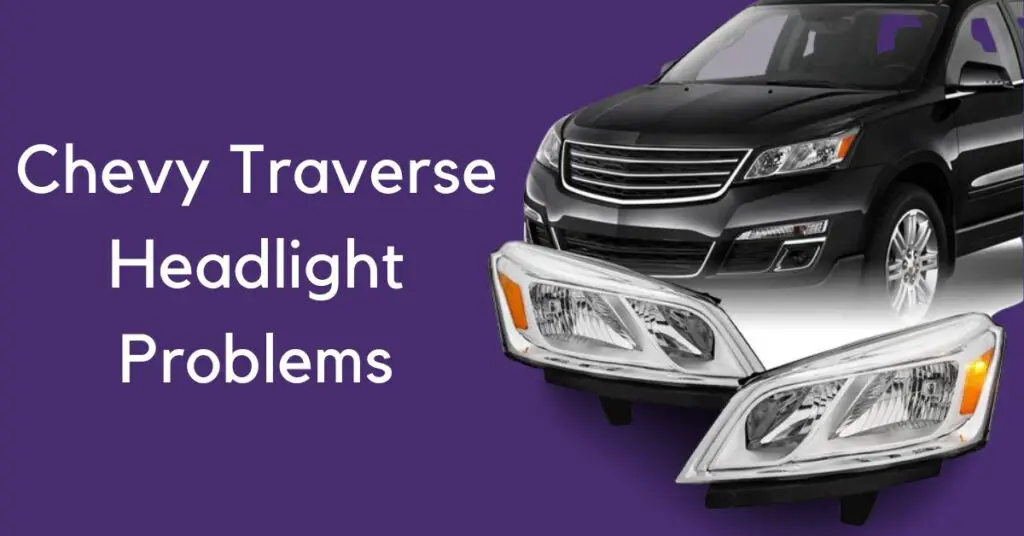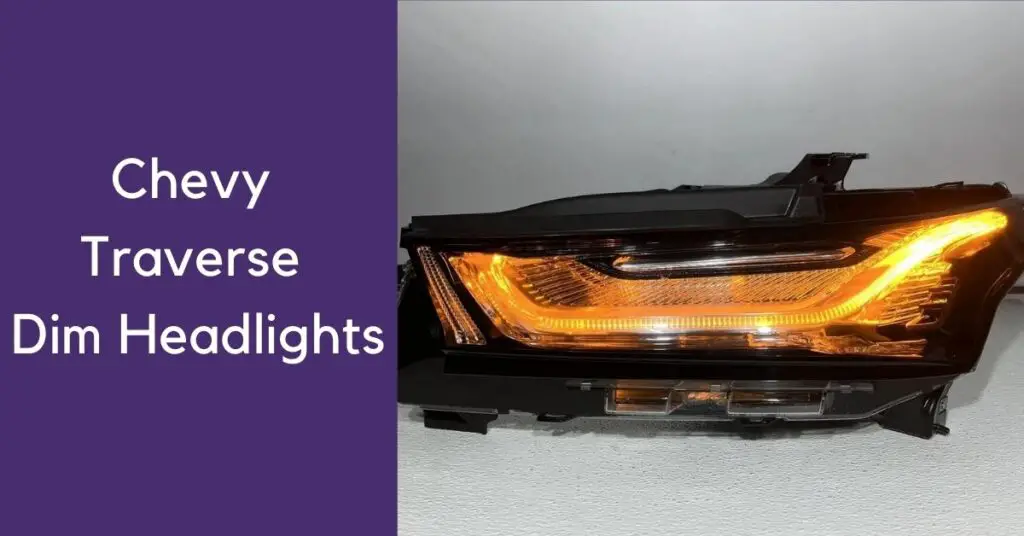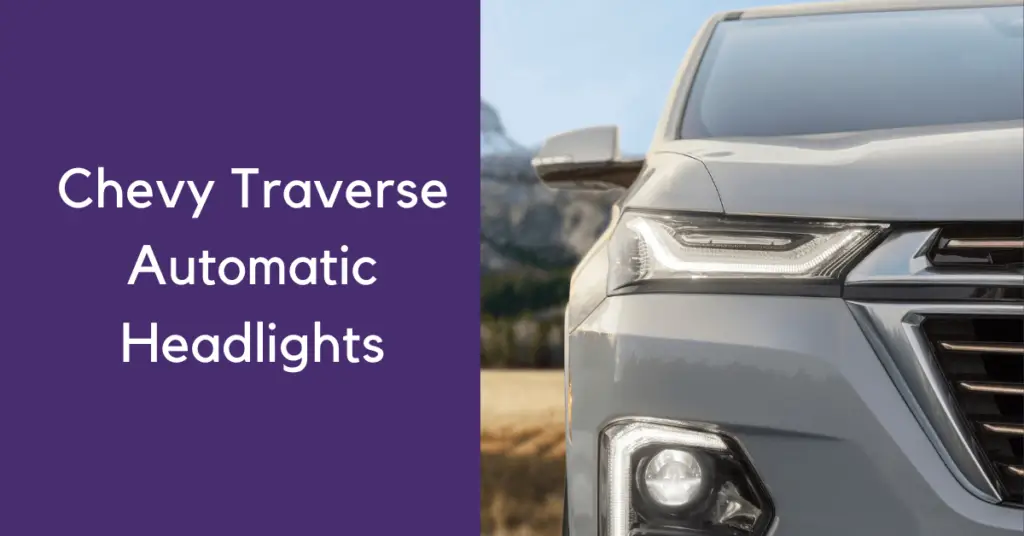Many owners have reported frustrating Chevy traverse issues, compromising safety and visibility on nighttime trips. Whether you’re experiencing these problems firsthand or considering new headlights, understanding common causes and solutions is crucial.
This article delves into the real-world experiences of Traverse owners, drawing on their feedback, expert insights, and practical solutions to help you diagnose the problem and navigate the path toward brighter, safer drives.

following are The Chevy Traverse Headlight Problems:
1) Dim Headlights:
Dim headlights are a common headlight problem in Chevy Traverse. Dim headlights refer to a situation where the headlights of the Chevy Traverse appear significantly less bright than normal. Dim headlights result in reduced visibility, especially in low-light or dark conditions.

Dim Headlights in Chevy Traverse can occur due to a faulty regulator because a faulty regulator provides irregular voltage to the headlight bulb which then leads to dim headlights. A weak or dying battery can also lead to dim headlights in Chevy Traverse because headlights require a significant amount of electrical power to function properly. When the battery is weak, it cannot provide enough voltage to the headlights, resulting in dim illumination. You don’t need professional help for this Chevy Traverse headlight issue because by just purchasing a new alternator or battery and following the steps below, you can fix it yourself.
How To Fix It?
If the regulator is faulty, start by inspecting your Chevy Traverse headlights to ensure that the bulbs are not damaged. If they appear dim, replace them with new bulbs of the appropriate type and wattage. You should follow the instructions in the vehicle’s manual to replace the bulb. Then, inspect the electrical connections related to the headlights, including the wiring harness, connectors, and ground connections. Clean any corrosion or dirt present in your Chevy Traverse headlights and ensure that the wires are tight because loose or corroded wire connections can cause voltage drops.
If the battery is weak, test the battery’s voltage. If the voltage is less than 12v, this means the battery is weak and you need to replace it.
2) Headlight Moisture Buildup:
Headlight moisture buildup is another major Chevy Traverse Headlight Problem. Moisture inside the headlights can not only degrade visibility but also cause damage to the headlight parts, leading to possible safety concerns.

Poor installation of headlights can cause this problem because there is a high probability that improperly installed or repaired headlight housing could have gaps or faulty seals that allow moisture to enter.
Ventilation issue also leads to moisture buildup because Chevy traverse headlights are designed with ventilation systems that allow air to circulate and prevent dampness buildup. If the ventilation system is blocked, barred, or damaged, it can interfere with the proper airflow, leading to wetness retention inside the headlights. Professional help is not necessary for this Chevy Traverse headlight issue because by just following the steps below, you can fix it yourself.
How To Fix It?
Check the headlight body of the Chevy Traverse for any visible signs of damage, such as cracks, holes, or damaged seals. Identify whether moisture buildup is related to external factors, such as damaged seals or materials, or internal factors, such as defective ventilation.
Then park the vehicle in a dry and warm area, letting natural evaporation of the water. You can also use a hairdryer on a low setting to blow warm air into the headlight body because it can help speed up the drying process.
After that apply a headlight sealant or silicone adhesive around the seals and edges of the headlight assembly. This additional layer of protection can help reinforce the seals and prevent moisture from entering the headlights. Follow the instructions provided with the sealant to apply it.
3) Flickering or Strobing Headlights:
Flickering or strobing headlights are a common chevy traverse headlight problem. This issue occurs when the headlights intermittently flash or flicker, causing inconsistent illumination. It’s not only annoying when your headlights flicker, but it can also pose a safety risk, as it may reduce visibility and distract other car drivers.

Damaged or faulty wiring within the headlight system can cause flickering because, over time, connections within the wiring harness can become loose due to vibration, wear and tear, or improper installation. This creates inconsistent contact and disrupts the smooth flow of electricity, leading to flickering.
A faulty alternator can also be a reason for flickering headlights in the Chevy Traverse because a failing alternator can cause changes in voltage, leading to flashing or strobing headlights. It is recommended to consult a qualified mechanic for proper diagnosis and repair of this problem, especially if you’re not comfortable with electrical repairs or are unsure about the cause.
How To Fix It?
First, inspect the wiring for damage or corrosion. If found, replace it. Then, check the alternator of the Chevy Traverse and make sure that it is working correctly and supplying stable voltage to the electrical accessories in the car. If the alternator is found to be defective, replace it with a new one.
If you have added aftermarket accessories or modifications that want excessive power, please remove or reduce the load on the electrical system. Excessive power demands can damage the system, leading to voltage fluctuations and flickering headlights.
4) Automatic Headlight Malfunction:
Automatic headlight malfunction is a frustrating Chevy traverse headlight problem that occurs when the automatic headlight system fails to function, resulting in issues such as headlights not turning on or not turning off when necessary. Automatic headlights are designed to provide comfort and provide visibility by automatically adjusting the light based on different ambient conditions.

Faulty sensors can cause this problem because automatic headlight systems depend on sensors to detect ambient light conditions. If the sensor is dirty, blocked, or malfunctioning, it may not accurately detect the light levels, leading to inappropriate functioning of the automatic headlight system. In some cases, the sensor may need cleaning or adjustment, while in other cases, it may require replacement.
The automatic headlight system is also dependent on specific fuses to function correctly. The automated headlights may stop working if a fuse connected to the system does not work. Therefore, the headlight system’s fuses should always be tested before driving. It is recommended to consult a professional mechanic for a solution to this problem, but if you are knowledgeable and have the necessary qualifications, you can follow the below guide to fix it yourself.
How To Fix It?
Inspect the sensor responsible for detecting ambient light levels inside the Chevy Traverse. Ensure the sensor is clean, free from obstructions, and properly aligned. Clean any dirt or debris on the sensor using a soft cloth or compressed air. If the sensor is damaged or not functioning correctly, it may need to be replaced.
If the automatic headlight malfunction still happens, try resetting the control module. Then, disconnect the vehicle’s battery for a few minutes, then reconnect it. This may reset the control module and resolve any software glitches causing the malfunction.
5) Headlight damage:
Headlight damage affects the functionality, visibility, and aesthetics of the headlights. Chevy Traverse headlights experience physical damage due to various factors such as accidents, impacts, the road remains, and environmental elements. When headlights are damaged, it can compromise their ability to provide satisfactory illumination and lead to reduced visibility and safety concerns.

Front-end collisions, fender benders, or even hitting road debris can result in cracked or shattered headlights. Exposure to certain chemicals or cleaning agents that are not compatible with the headlight materials can also cause headlight damage because some chemicals react with the plastic lens, causing discoloration or even erosion. Therefore, It’s essential to use appropriate cleaning products specifically designed for headlights.
How To Fix It?
If the damage is limited to a specific component of Chevy traverse headlights, such as a cracked lens or a broken mounting bracket, you may be able to replace that component individually. Headlight components are often available for purchase separately, allowing you to replace the damaged part without replacing the entire headlight unit.
In some circumstances, headlight damage may require experienced repair. If the damage is vast or headlight unit is hardly cracked, or you are doubtful about the repair process, it is recommended to pursue the service of a qualified mechanic or automotive technician.
5 Prevention Tips for Chevy Traverse Headlight Problems

1) Check headlight functionality regularly:
Checking headlight functionality refers to checking the functionality of high beams, low beams, turn signals, light intensity, color consistency, automatic activation, and fog lights.
What to Check:
- High and low beams: Turn them on and check for brightness and proper focus. Are they strong enough to light the road?
- Turn signals and fog lights: Ensure they activate correctly and display the appropriate colors. Imagine other drivers needing to see your signals.
- Color consistency: While headlights typically have a white or slightly blueish hue, mismatched or uneven colors might indicate an issue.
How to Check:
- Park your car in a dark area with a flat surface ahead.
- Turn on your headlights and walk around the vehicle, observing their functionality and beam pattern.
- Ask a friend to sit inside and activate turn signals/fog lights while you observe them from outside.
Always, keep in mind that well-functioning headlights improve visibility at night and in low-light conditions, helping you spot hazards and avoid accidents.
2) Replace bulbs proactively:
Replacing bulbs proactively even before they completely fail is a good way to maintain optimal visibility.
Consult your owner’s manual or manufacturer information to understand the average lifespan of your Traverse’s headlight bulbs. Additionally, when replacing one bulb, consider replacing the other even if it still works. This ensures consistent brightness and avoids replacing the remaining bulb soon after. While choosing the bulb, make sure the replacement bulb is high quality (LED bulbs) and compatible with your specific Traverse model and headlight configuration.
3) Align headlights properly:
Misaligned headlights pose serious safety risks by reducing visibility and distracting other drivers. They can be misaligned due to:
- Normal wear and tear: Over time, components can shift, affecting alignment.
- Hitting bumps or potholes: Impacts can jolt headlights out of alignment.
- Modifications or repairs: Certain repairs or modifications may affect alignment.
Signs of misalignment:
- Uneven light pattern: One headlight aiming higher or lower than the other.
- Complaints from other drivers: If they find your headlights too bright or misdirected.
- Reduced visibility: You don’t see the road ahead clearly at night.
Alignment recommendations:
- Seek professional alignment at least once a year: This ensures accurate and safe adjustments by qualified technicians.
- Check for signs of misalignment more frequently: Especially after hitting bumps or experiencing potential impacts.
- Consult your owner’s manual: Only attempt DIY adjustments if your model offers them and you’re confident and equipped for safe adjustments. Remember, prioritizing professional service is crucial for optimal safety and performance.
4) Regular Professional Servicing:
Regular professional servicing for your Chevy Traverse headlights goes beyond basic cleaning. It ensures optimal performance and prevents potential issues by:
- Performing comprehensive checks: This includes headlight alignment, bulb condition, aiming verification, reflector cleaning, and other crucial aspects.
- Catching problems early: Professionals have the expertise and equipment to identify minor issues like wear, moisture buildup, or wiring concerns before they become major problems.
- Maximizing efficiency and lifespan: Regular servicing helps ensure your headlights function optimally, potentially extending their lifespan.
5) Warranty Awareness:
Understanding your Chevy Traverse’s warranty coverage can be beneficial when facing headlight issues. Remember:
- Coverage varies: Headlight components may or may not be covered under your warranty depending on its terms and the specific issue. Consult your owner’s manual, dealership, or manufacturer’s website to understand your specific coverage details.
- Benefits beyond cost savings: Warranties provide peace of mind knowing certain repairs are covered, potentially saving you from unexpected expenses.
- Review exclusions: Warranties often have limitations and exclusions. Carefully review your warranty terms and conditions to understand what’s covered and what’s not.
Headlight Problems in Other Car Models:
- Bad Boy Buggy headlight problems
- 2015 GMC Sierra headlight problems
- GQ Patrol Headlight Problems
- Cultus Headlight Problems
FAQs

1) What tools are required to fix Chevy traverse headlights?
To fix Chevy Traverse headlights, you will need the following tools:
- Screwdriver or socket set: Depending on the model year of your Chevy Traverse, you may need either a Phillips or Torx screwdriver or a socket set to remove the screws holding the headlight assembly in place.
- Pliers: These may be needed to disconnect any electrical connectors or remove clips holding the headlight assembly.
- Replacement bulbs: If the issue is a burnt-out bulb, you will need to purchase a new one that is compatible with your Chevy Traverse’s headlights.
2) Are LED Upgrades A Viable Solution for Chevy Traverse Headlight Issues?
Yes, they can be a viable option because LED headlights offer many advantages, such as increased brightness, longer lifespan, and energy efficiency. LED can provide better visibility at night, which can enhance safety. However, it is important to ensure that the LED upgrade you choose is compatible with your Chevy Traverse’s headlight assembly.
3) What is the lifespan of LED headlights in Chevy Traverse?
The lifespan of LED headlights in a Chevy Traverse can vary depending on the quality of the LEDs and their usage. Generally, LED headlights have a longer lifespan compared to traditional halogen bulbs. They can last anywhere from 20,000 to 50,000 hours or more. However, it is worth noting that the lifespan can be affected by factors such as the quality of the LEDs, the driving conditions, and how often the headlights are used.
4) What steps can be taken to diagnose why the headlights on a Chevy Traverse aren’t working?
4 Top Reasons Your Headlights May Not Be Working:
- Burned-Out Bulbs
- Damaged Relay
- Wiring Problem
- Electrical connection issue
5) Are the headlight problems and solutions mentioned above also suitable for other models of Chevy Traverse?
Yes, all the above-mentioned problems and solutions are also applicable to all models of Chevy Traverse from 2005 to 2023.
Do you have questions about Chevy Traverse headlight problems? Ask away in the comments! Share your experiences, suggest solutions, and learn from fellow owners.
